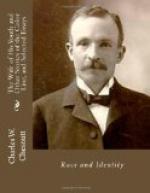of no value whatever as a test of race. It belongs
with the grewsome superstition that a woman apparently
white may give birth to a coal-black child by a white
father. Another instance that came under my eye
was that of a very beautiful girl with soft, wavy brown
hair, who is now living in a Far Western State as
the wife of a white husband. A typical case was
that of a family in which the tradition of Negro origin
had persisted long after all trace of it had disappeared.
The family took its origin from a white ancestress,
and had consequently been free for several generations.
The father of the first colored child, counting the
family in the female line—the only way it
could be counted—was a mulatto. A
second infusion of white blood, this time on the paternal
side, resulted in offspring not distinguishable from
pure white. One child of this generation emigrated
to what was then the Far West, married a white woman
and reared a large family, whose descendants, now
in the fourth or fifth remove from the Negro, are in
all probability wholly unaware of their origin.
A sister of this pioneer emigrant remained in the
place of her birth and formed an irregular union with
a white man of means, with whom she lived for many
years and for whom she bore a large number of children,
who became about evenly divided between white and
colored, fixing their status by the marriages they
made. One of the daughters, for instance, married
a white man and reared in a neighboring county a family
of white children, who, in all probability, were as
active as any one else in the recent ferocious red-shirt
campaign to disfranchise the Negroes.
In this same town there was stationed once, before
the war, at the Federal arsenal there located, an
officer who fell in love with a “white Negro”
girl, as our Southern friends impartially dub them.
This officer subsequently left the army, and carried
away with him to the North the whole family of his
inamorata. He married the woman, and their descendants,
who live in a large Western city, are not known at
all as persons of color, and show no trace of their
dark origin.
Two notable bishops of the Roman Catholic communion
in the United States are known to be the sons of a
slave mother and a white father, who, departing from
the usual American rule, gave his sons freedom, education
and a chance in life, instead of sending them to the
auction block. Colonel T.W. Higginson, in
his Cheerful Yesterdays, relates the story
of a white colored woman whom he assisted in her escape
from slavery or its consequences, who married a white
man in the vicinity of Boston and lost her identity
with the colored race. How many others there must
be who know of similar instances! Grace King,
in her “Story of New Orleans,” to which
I have referred, in speaking of a Louisiana law which
required the public records, when dealing with persons
of color, always to specify the fact of color, in
order, so far had the admixture of races gone, to
distinguish them from whites, says: “But
the officers of the law could be bribed, and the qualification
once dropped acted, inversely, as a patent of pure
blood.”




